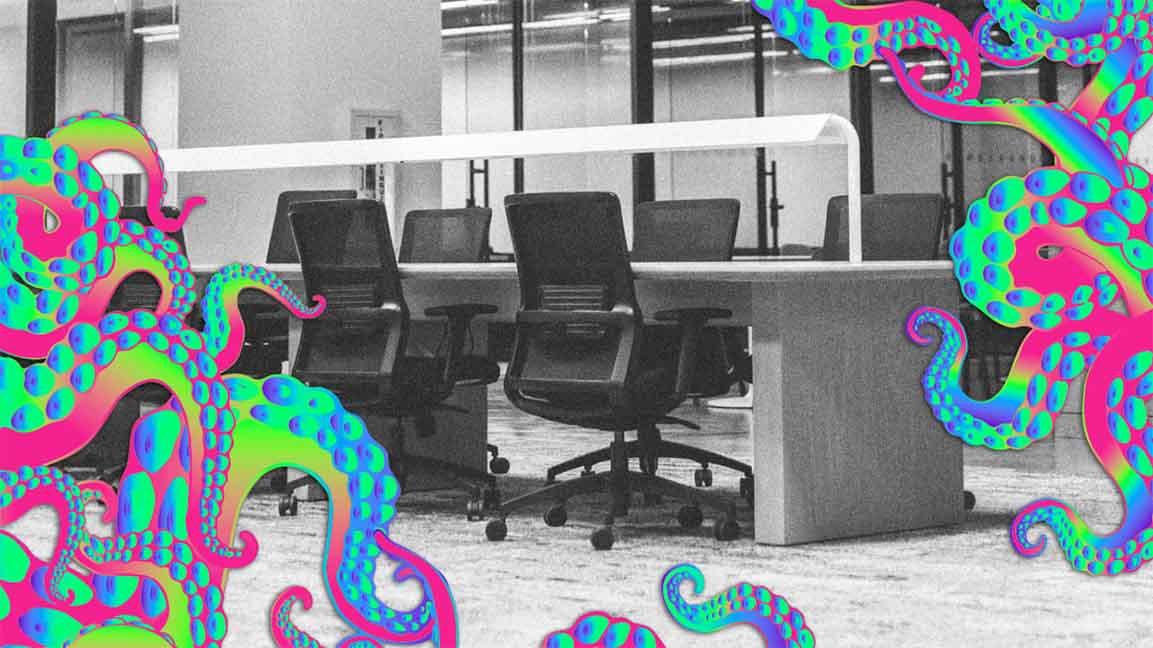- | 2:00 pm
How to slay your ‘anxiety monster’ and reclaim happiness at work
Ever feel like your work days have become a Kafkaesque parade of irritating moments? You’re not alone, this author says. But all too often, the problem is psychological self-sabotage.

The following is adapted from the new book Work Here Now: Think Like a Human and Build a Powerhouse Workplace by Melissa Swift.
I’d like to introduce you to a character scarier than any horror movie villain you’ve ever encountered: the Work Anxiety Monster. It’s in us all, and it’s in every organization.
Any student of psychology will tell you that a serious impediment to human happiness and success is the negative stories we sometimes tell ourselves. We run into a friend who’s rushing somewhere and think that because he couldn’t talk for long, he must be getting bored with our friendship. Kid has a stomachache? Must be a catastrophic illness. And so on. For many people, cognitive behavioral therapy is incredibly helpful in fighting depression and anxiety because it causes them to tackle these negative stories and rewrite them into more realistic, constructive narratives. (“Larry must have been in a hurry! I know he has a demanding job,” or, “Little Susie probably just ate her spaghetti too fast, just like the last three times.”)
The problem in organizations is that our individually strange storytelling about work adds up to organization-level warped narratives. Those catastrophizing stories form a collective anxiety monster that constantly demands to be fed—and contorts the work experience into a Kafkaesque parade of irritating moments. Flawed, anxious thinking gets baked into everything from organizational design to individual processes to workforce decisions from large populations to individual hiring.
The Work Anxiety Monster is effective in part because it only has two simple, interrelated themes, which it repeats over and over to devastating effect: People are lazy, and people are slow. On those two misdirected assumptions about human behavior are founded millions of lousy days at work. The issue is not that every manager explicitly believes those things. Rather, over the years, enough managers have believed in these things that not many facets of organizations over-rotate on trying to correct for these problems.
Some version of the Work Anxiety Monster has likely been around throughout human history. But it’s a safe bet that both the Industrial Revolution and a more global way of working escalated the Work Anxiety Monster’s nefarious efforts. As managers became more removed from work—physically or intellectually—their ruminating brains filled in what they couldn’t see about their direct reports’ day-to-day work with those two anxious messages: “People are lazy! People are slow!”
In fact, at times when work is changing dramatically, people may look like they are lazy and slow. I taught myself to fix a toilet recently—replacing the entire innards of the darn thing. A professional plumber would have done the work in a tiny fraction of the time it took me, but also would have looked more expedient doing it. My brain needed to process the learning in real time and work on the problems that were coming up, so I kept wandering off to get snacks, answer emails, etc. I wasn’t being lazy or slow—this was a natural way of working on something novel.
What’s interesting about contemporary work—physical work and knowledge work alike—is that across many jobs, the nature of work changes so fast that the folks doing it find themselves repeatedly new to it and thus appear lazy/slow. The Pew Center cites a dramatic escalation in social and analytical skills required across many professions in the 35-year period from 1980 to 2015 (83% greater need, and 77% greater need, respectively). That’s a complete sea-change in one person’s lifetime.
During the COVID-19 period, that already high rate of change accelerated dramatically, as entire workforces shifted from in-person to virtual work, learned to do tasks with sparser personnel, and in general reconfigured work on the fly due to ever-shifting health and safety concerns. This ever-quickening rate of change means that we are, in some ways, as my gamer daughter would say, eternal “noobs”—chronically visibly new to the game we’re playing . . . and looking artificially slow and lazy as a result.
In a time of fast skills change, it’s more crucial than ever to keep the Work Anxiety Monster at bay. How do we keep this insidious figure from pushing us toward decisions that actually impede both productivity and worker happiness? And importantly, how do we slay this monster within our own working teams?
Within an organization, slaying the Work Anxiety Monster starts with understanding “the thinking behind the decisions.” Let’s take a recent example: decisions about remote work. If your organization decided to prioritize more in-person work, was it for positive reasons (building company culture and nurturing early-in-career workers), or Work Anxiety Monster reasons (“I don’t fully understand the work my people do, so gosh darn it, I need to watch them do it!”) If the Work Anxiety Monster is calling the shots, tell it to shut up. Take the time to better understand the underlying work that people do, and make decisions that aren’t anxiety-laced.
Within a team, a great place to start on slaying the Work Anxiety Monster is by teeing up a conversation about pace. Often we reflexively move quickly without understanding what is driving our timelines. We just have the Work Anxiety Monster whispering in our ear, “Faster, faster!” Consciously talking about the right speed to get work done, especially new types of work – and critically, what’s actually involved in getting something accomplished (something managers serially underestimate) – will set a sustainable and productive pace, rather than the erratic sprinting and tripping up that drives leaders and employees alike to distraction.
The Work Anxiety Monster is a menace. But by taking action at organization and team level, we can dispatch it, and work both better and smarter.








































